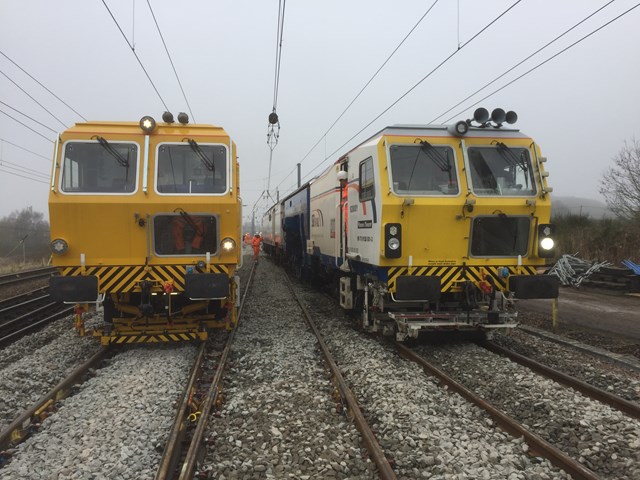
Joining engineering trains together so that they can complete engineering works faster could help save £250,000 per week in costs by eliminating the gap between completing the works and train services running at full speed, according to Network Rail. The company has for the first time used 'formation flying' trains to carry out simultaneous operations during a repair to rails.
The innovative repair occurred at Sandy in Bedfordshire over the weekend, where a set of switches and crossings – points where trains can switch from one track to another – were being replaced as part of a rail upgrade plan. Normally, where track has been replaced, trains must run at reduced speeds over the new track until the ballast below the line has settled to form a firm bedding. Network Rail typically has to pay compensation to operating companies for the delays this causes.
However, this weekend, the company joined a pair of engineering trains by an umbilical so they ran parallel to each other, simultaneously tamping down the ballast and carrying out dynamic stabilisation of the new track in an operation that simulated 200 trains passing over the new switches and crossings one after the other. This allowed passenger trains to start using the new section at speeds up to 125 mph immediately after the works were completed.
Network Rail has been working on so-called ‘high–speed handbacks’ for the past year, and achieved the first on a section of straight track in January 2016. Last weekend's operation represents the first time a high-speed hand back had been managed on a crossing, the section where there is a gap in the rail for the wheel to pass through once the points have been set. Key to this process is progressive assurance that each part of the replacement Is complete before the service starts running again.
“We have been continually improving [ high-speed handback], systematically getting better at every aspect of what we do,” said Steve Featherstone, programme manager for track at Network Rail. “We have progressively built the knowledge and competence to handback plain line, high output and switches and crossing renewals at 125mph, which will save Network Rail hundreds of thousands of pounds in reduced fees to train operators for disruption caused.”
As well as reducing the need for compensation and reducing delays for passengers, this technique improves safety for rail workers, as they need to spend less time trackside doing jobs such as placing speed boards for oncoming trains, Network Rail says.




Report highlights significant impact of manufacturing on UK economy
I am not convinced that the High Value Manufacturing Centres do anything to improve the manufacturing processes - more to help produce products (using...